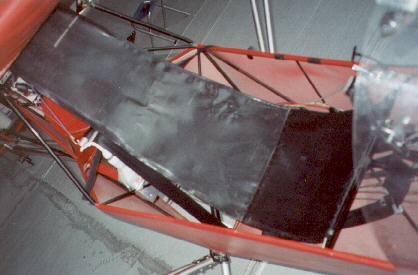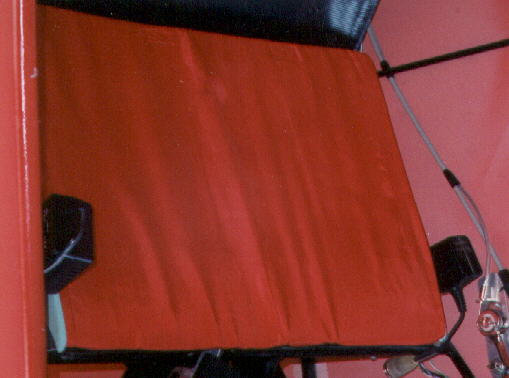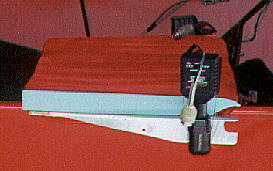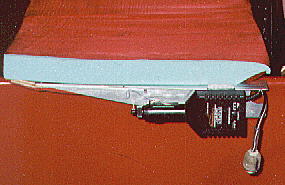Sling Seat, Seat Modifications and GPS & Radio Power Supplies
 I am short legged and long in the trunk so that I had to put in a seat cushion to move me forward to get onto the rudder pedals. Also I found on cross country flights that the front seat cross piece was too high and cut off the blood to my legs and so I made another cushion to take care of the problem. Then I realized that if I went to a sling seat it would be approximately the same seat form. So I removed aluminum strip that was riveted to lower seat bottom to turn seat into a sling seat. Saved three pounds of foam and fabric, and it works great.
I am short legged and long in the trunk so that I had to put in a seat cushion to move me forward to get onto the rudder pedals. Also I found on cross country flights that the front seat cross piece was too high and cut off the blood to my legs and so I made another cushion to take care of the problem. Then I realized that if I went to a sling seat it would be approximately the same seat form. So I removed aluminum strip that was riveted to lower seat bottom to turn seat into a sling seat. Saved three pounds of foam and fabric, and it works great.
|
 Later on I discovered that there are some disadvantages to the sling seat. First one has a tendency to slump and to slide forward in the seat. This means that before you start the take off roll, one must be sure you are pushed back far enough so that you can get the stick back against the stop or you end up with a long take off roll. Also, after an extended flight, one must get pushed back or you will be rubbing your stomach with the stick when you try to rotate upon landing. To reduce the tendency to slip forward in the sling seat, I made what I call a cheek board. This is a piece of thin wood wall paneling cut to the seat width. It was cut long and then shortened until I could sit in the seat with out hitting my head and so that it sloped down hill toward the back so that I would not have a tendency to slide forward. I purchased a piece of stiff seat cushion foam so that I could sit in the seat for an hour at a time.
Later on I discovered that there are some disadvantages to the sling seat. First one has a tendency to slump and to slide forward in the seat. This means that before you start the take off roll, one must be sure you are pushed back far enough so that you can get the stick back against the stop or you end up with a long take off roll. Also, after an extended flight, one must get pushed back or you will be rubbing your stomach with the stick when you try to rotate upon landing. To reduce the tendency to slip forward in the sling seat, I made what I call a cheek board. This is a piece of thin wood wall paneling cut to the seat width. It was cut long and then shortened until I could sit in the seat with out hitting my head and so that it sloped down hill toward the back so that I would not have a tendency to slide forward. I purchased a piece of stiff seat cushion foam so that I could sit in the seat for an hour at a time.
|
 A piece of scrap aluminum was cut, shaped and attached to each side of the board with a cut out for the front seat cross piece. This keeps the board from sliding too far forward. Plug in power for the radio and gps was placed on each side toward the front. The leading edge of the foam was cut to a taper with an electric carving knife so that the edge would not cause a high pressure area on the bottom of one's legs. A cloth loop keeps the whole thing together.
A piece of scrap aluminum was cut, shaped and attached to each side of the board with a cut out for the front seat cross piece. This keeps the board from sliding too far forward. Plug in power for the radio and gps was placed on each side toward the front. The leading edge of the foam was cut to a taper with an electric carving knife so that the edge would not cause a high pressure area on the bottom of one's legs. A cloth loop keeps the whole thing together.
|
 I discovered that I bumped the gps power supply as I got into the FireFly and the radio power supply interfered with the carburetor enrichment lever. I discarded the electrical sockets, rotated each power supply 90 degrees, fixed them permanently to the aluminum rails and hard wired them. This gives one a little more seat room and the power supplies do not get in the way.
I discovered that I bumped the gps power supply as I got into the FireFly and the radio power supply interfered with the carburetor enrichment lever. I discarded the electrical sockets, rotated each power supply 90 degrees, fixed them permanently to the aluminum rails and hard wired them. This gives one a little more seat room and the power supplies do not get in the way.
|
Update - December 26, 2005
To reduce FireFly dry weight and preparation time after getting into the FireFly, I removed the power supplies from the seat board. I moved them into a flight vest so that they could remain connected to the radio and gps. With the vest, I can get everything ready to go before I get into the FireFly. All I have to do is hook up one power tap, connect the antenna, and place the microphone switch on the stick. This arrangement can be seen at click. If you wish to come back to this page you must use your browser back icon.
|
 I am short legged and long in the trunk so that I had to put in a seat cushion to move me forward to get onto the rudder pedals. Also I found on cross country flights that the front seat cross piece was too high and cut off the blood to my legs and so I made another cushion to take care of the problem. Then I realized that if I went to a sling seat it would be approximately the same seat form. So I removed aluminum strip that was riveted to lower seat bottom to turn seat into a sling seat. Saved three pounds of foam and fabric, and it works great.
I am short legged and long in the trunk so that I had to put in a seat cushion to move me forward to get onto the rudder pedals. Also I found on cross country flights that the front seat cross piece was too high and cut off the blood to my legs and so I made another cushion to take care of the problem. Then I realized that if I went to a sling seat it would be approximately the same seat form. So I removed aluminum strip that was riveted to lower seat bottom to turn seat into a sling seat. Saved three pounds of foam and fabric, and it works great.
 Later on I discovered that there are some disadvantages to the sling seat. First one has a tendency to slump and to slide forward in the seat. This means that before you start the take off roll, one must be sure you are pushed back far enough so that you can get the stick back against the stop or you end up with a long take off roll. Also, after an extended flight, one must get pushed back or you will be rubbing your stomach with the stick when you try to rotate upon landing. To reduce the tendency to slip forward in the sling seat, I made what I call a cheek board. This is a piece of thin wood wall paneling cut to the seat width. It was cut long and then shortened until I could sit in the seat with out hitting my head and so that it sloped down hill toward the back so that I would not have a tendency to slide forward. I purchased a piece of stiff seat cushion foam so that I could sit in the seat for an hour at a time.
Later on I discovered that there are some disadvantages to the sling seat. First one has a tendency to slump and to slide forward in the seat. This means that before you start the take off roll, one must be sure you are pushed back far enough so that you can get the stick back against the stop or you end up with a long take off roll. Also, after an extended flight, one must get pushed back or you will be rubbing your stomach with the stick when you try to rotate upon landing. To reduce the tendency to slip forward in the sling seat, I made what I call a cheek board. This is a piece of thin wood wall paneling cut to the seat width. It was cut long and then shortened until I could sit in the seat with out hitting my head and so that it sloped down hill toward the back so that I would not have a tendency to slide forward. I purchased a piece of stiff seat cushion foam so that I could sit in the seat for an hour at a time.
 A piece of scrap aluminum was cut, shaped and attached to each side of the board with a cut out for the front seat cross piece. This keeps the board from sliding too far forward. Plug in power for the radio and gps was placed on each side toward the front. The leading edge of the foam was cut to a taper with an electric carving knife so that the edge would not cause a high pressure area on the bottom of one's legs. A cloth loop keeps the whole thing together.
A piece of scrap aluminum was cut, shaped and attached to each side of the board with a cut out for the front seat cross piece. This keeps the board from sliding too far forward. Plug in power for the radio and gps was placed on each side toward the front. The leading edge of the foam was cut to a taper with an electric carving knife so that the edge would not cause a high pressure area on the bottom of one's legs. A cloth loop keeps the whole thing together.
 I discovered that I bumped the gps power supply as I got into the FireFly and the radio power supply interfered with the carburetor enrichment lever. I discarded the electrical sockets, rotated each power supply 90 degrees, fixed them permanently to the aluminum rails and hard wired them. This gives one a little more seat room and the power supplies do not get in the way.
I discovered that I bumped the gps power supply as I got into the FireFly and the radio power supply interfered with the carburetor enrichment lever. I discarded the electrical sockets, rotated each power supply 90 degrees, fixed them permanently to the aluminum rails and hard wired them. This gives one a little more seat room and the power supplies do not get in the way.